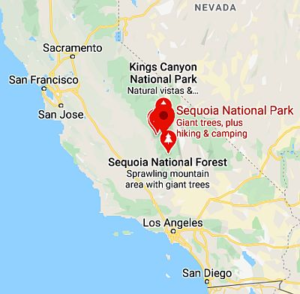In news– Two wildfires in California, one called the Colony fire and the other called Paradise – are burning through the Sequoia National Park in the Sierra Nevada that is home to some of the largest trees in the world, which also include General Sherman, the world’s largest tree.
About General Sherman tree-
- It is a giant sequoia (Sequoiadendron giganteum) tree located in the Giant Forest of Sequoia National Park in Tulare County, in the U.S. state of California.
- It is the world’s largest in terms of volume (single stem tree) and exists in the Giant Forest sequoia grove of the national park.
- As per recent estimates, it is about 2,200 years old.
- The General Sherman was named after the American Civil War general William Tecumseh Sherman.
- It stands at a height of 275 feet (taller than the leaning tower of Pisa) and has a diameter of 36 feet at the base.
- While the General Sherman is the largest currently living tree, it is not the largest historically recorded tree.
- The Lindsey Creek tree, with more than 90,000 cubic feet (2,500 cubic meters) almost twice the volume of General Sherman, was reportedly felled by a storm in 1905.
- The General Sherman Tree is neither the tallest known living tree on Earth (that distinction belongs to the Hyperion tree, a Coast redwood), nor is it the widest (both the largest cypress and largest baobab have a greater diameter), nor is it the oldest known living tree on Earth (that distinction belongs to a Great Basin bristlecone pine).
Sequoia National Park-
- Sequoia National Park is adjacent to Kings Canyon National Park in California’s southern Sierra Nevada mountains, the USA.
- It’s known for its huge sequoia trees, notably the General Sherman Tree dominating the Giant Forest.
- The park was established on September 25, 1890.

- The underground Crystal Cave features streams and striking rock formations.
- Moro Rock is a granite dome offering sweeping park views.
- Sequoia trees in the National Park are fairly fire-resistant.
- It is the only area in the world where giant sequoias occur naturally.
- UNESCO designated the areas as Sequoia-Kings Canyon Biosphere Reserve in 1976.














